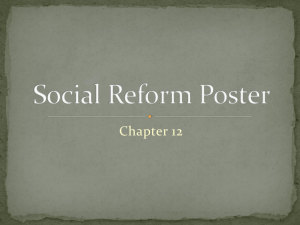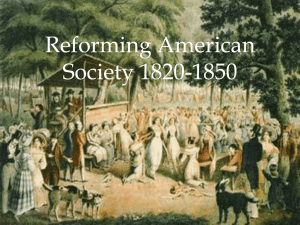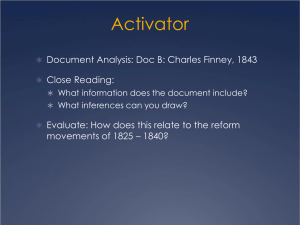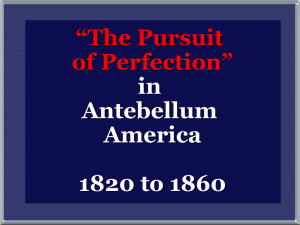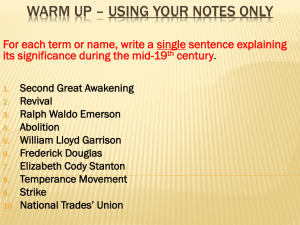TEACHER: CLASS: 8th Grade DATE: February 15
advertisement
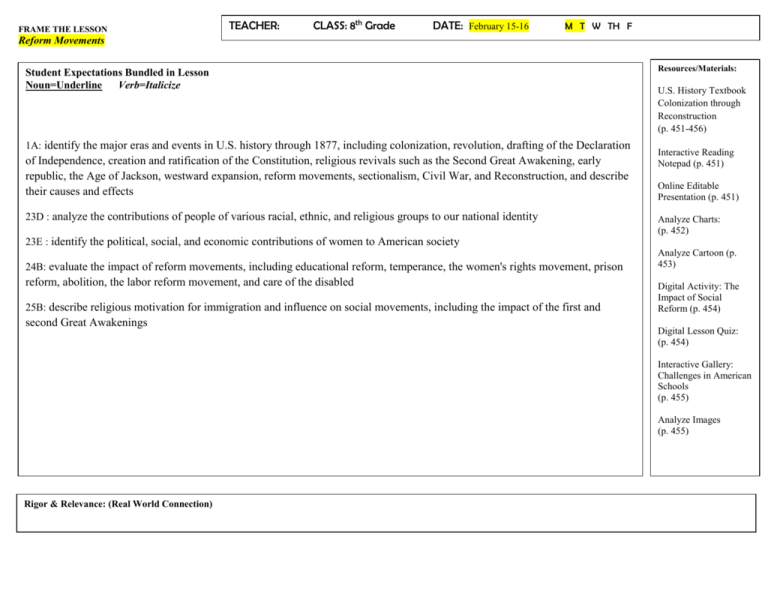
FRAME THE LESSON TEACHER: CLASS: 8th Grade DATE: February 15-16 M T W TH F Reform Movements Student Expectations Bundled in Lesson Noun=Underline Verb=Italicize 1A: identify the major eras and events in U.S. history through 1877, including colonization, revolution, drafting of the Declaration of Independence, creation and ratification of the Constitution, religious revivals such as the Second Great Awakening, early republic, the Age of Jackson, westward expansion, reform movements, sectionalism, Civil War, and Reconstruction, and describe their causes and effects 23D : analyze the contributions of people of various racial, ethnic, and religious groups to our national identity Resources/Materials: U.S. History Textbook Colonization through Reconstruction (p. 451-456) Interactive Reading Notepad (p. 451) Online Editable Presentation (p. 451) Analyze Charts: (p. 452) 23E : identify the political, social, and economic contributions of women to American society 24B: evaluate the impact of reform movements, including educational reform, temperance, the women's rights movement, prison reform, abolition, the labor reform movement, and care of the disabled 25B: describe religious motivation for immigration and influence on social movements, including the impact of the first and second Great Awakenings Analyze Cartoon (p. 453) Digital Activity: The Impact of Social Reform (p. 454) Digital Lesson Quiz: (p. 454) Interactive Gallery: Challenges in American Schools (p. 455) Analyze Images (p. 455) Rigor & Relevance: (Real World Connection) Objective/Key Understanding: Introduce Vocabulary Activity (p. 391) Explain how political and religious trends, including the Second Great Awakening, inspired reform movements. Describe the impact of movements for temperance and for the reform of mental health care and prisons. Explain the impact of movements for the reform of education and care for the disabled. Debtor Temperance movement Second Great Awakening social reform revival predestination Critical Writing Prompt: Informal Assessment Questions 1-5 (p. 456) What did critics of American society feel was unjust about it? What was the Second Great Awakening, and why did it have the effects it had? Summarize Dorothea Dix’s efforts to improve society. Hypothesize why women so often took a leading role in the temperance movement? Contrast the educational opportunities available for white children an African American children in the North while educational reform was going on. Stop & Check for Understanding—High Level Questions What was the central premise on which the Second Great Awakening rested? Describe Dorotheas’ Dix’s legacy as a social reformer. Why did reformers insist that states set up publicly funded schools for their residents? Small Group Purposeful Talk Question Stems An Era of Reform (p. 452-453) Describe the causes of the Reform Era. How did the Second Great Awakening influence social movements? Social reform Movements (p. 453-455) What were some of the effects of reform movements? Why do you think women were leaders in the temperance movement? The Impact of Educational Reform (p. 455-456) Evaluate the impact of educational reform. How did Horace Mann’s efforts affect the public school system? Online Resources, Analyzing Maps and Charts & Digital Activity Interactive Reading Notepad (p. 451) You may also use the questions found in the Interactive Reading Notepad (p. 420) for this lesson to guide your class discussion. Online Editable Presentation (p. 451) Use the Online Editable Presentation (p. 451) found on the Digital Course to present the main ideas for this lesson. Analyze Charts: (p. 452) Review the chart on page 452. Based on the information in the chart, how did the reform movement reflect American culture in the 1800s? Analyze Cartoon (p. 453) Direct students’ attention to the political cartoon in the text, and have students describe what they see. What values did reformers hoped to instill in American society? How do you think religious beliefs shaped the values outline in the cartoon? How did these values contribute to our national identity? During the Second Great Awakening, preachers like the one in the camp meeting stressed the ability to save one’s soul through action. How did this teaching influence reform movements? Digital Activity: The Impact of Social Reform (p. 454) Present the Digital Activity: The Impact of Social Reform (p. 454). Have students fill in the chart and answer the questions. Have students discuss with a partner the reform they think were the most important and why. What do you think has been the lasting impact of the Reform Era? Discuss ways in which social reforms shaped the nation in the 1800s. Give examples. Of the examples you provided, how did these reform efforts influence American society today? Digital Lesson Quiz: (p. 454) Assign the Digital Lesson Quiz. Pose these questions: How did the Second great Awakening affect the American way of life? How did women contribute to reform movements in the 1800s? Cite examples for support. Analyze Images (p. 455) Direct students’ attention to the cartoon on page 455. Why did the cartoonist draw the tree so large with branches spread over everything pictured? Engage ~Have students preview the lesson objectives and the list of key terms (p.451). Use the Editable Presentation found on the digital course to present the main ideas of the lesson (p. 451). Complete the Start Up Activity on p 451. Tell students that social reform is an organized attempt to improve what is unjust or imperfect in society. Explain that the Second Great Awakening was a widespread religious movement in the United States in eh early 1800s. Why do you think a religious movement might lead people to work for social reform? Explore Tell students that in this lesson they will be learning about the causes and effect of reform movements inspired by the Second Great Awakening. ~Divide the class into groups. Each group is to read a section and be prepared to discuss and share findings with the class. Students are to read assigned sections and use the Note Taking Study Guide to help them take notes and understand the text as they read. An Era of Reform (p. 452-453) Social reform Movements (p. 453-455) The Impact of Educational Reform (p. 455-456) Tell students that in this lesson they will be learning about the causes and effect of reform movements inspired by the Second Great Awakening. Explain An Era of Reform (p. 452-453) As you have read, during the Jacksonian era, politics was becoming more democratic. More people could vote and take part in government than ever before. Social reform Movements (p. 453-455) The emphasis the Second Great Awakening place on improving society inspired many Americans. Women often played a leading role in these reform movements. These Americans launched a number of reform movements, with far-reaching effects on prisons, care of the disabled, education, and attitudes toward slavery. The Impact of Educational Reform (p. 455-456) In 1800, few American children attended school. Massachusetts was the only state that required free public schools supported by the community. Teachers were poorly trained and ill paid. Students of all ages crowded together in a single room. Elaborate Evaluate ~Guided Reading and Discussion Questions See Small Group Purposeful Talk Question Stems from the previous page for this portion of the lesson. ~Analyzing Maps and Charts & Digital Activity See Online Resources from the previous page for this portion of the lesson. ~Assign the Digital Lesson Quiz for this lesson (p. 456). Teachers can also opt to have students demonstrate mastery by responding to the following questions on paper: What did critics of American society feel was unjust about it? What was the Second Great Awakening, and why did it have the effects it had? Summarize Dorothea Dix’s efforts to improve society. Hypothesize why women so often took a leading role in the temperance movement? Contrast the educational opportunities available for white children an African American children in the North while educational reform was going on. FRAME THE LESSON Abolitionism TEACHER: CLASS: 8th Grade DATE: February 17-19 M T W TH F Student Expectations Bundled in Lesson Noun=Underline Verb=Italicize Resources/Materials: 7C: analyze the impact of slavery on different sections of the United States 20C: analyze reasons for and the impact of selected examples of civil disobedience in U.S. history such as the Boston Tea Party and Henry David Thoreau's refusal to pay a tax 21A: identify different points of view of political parties and interest groups on important historical and contemporary issues 22B: describe the contributions of significant political, social, and military leaders of the United States such as Frederick Douglass, John Paul Jones, James Monroe, Stonewall Jackson, Susan B. Anthony, and Elizabeth Cady Stanton 23D: analyze the contributions of people of various racial, ethnic, and religious groups to our national identity 23E identify the political, social, and economic contributions of women to American society 24: describe the historical development of the abolitionist movement 24B: evaluate the impact of reform movements, including educational reform, temperance, the women's rights movement, prison reform, abolition, the labor reform movement, and care of the disabled Objective/Key Understanding: Describe the historical development of the abolitionist movement. Explain the roles of Frederick Douglass and others in the abolitionist movement. Identify the Underground Railroad and the role that civil disobedience played in it. Describe the different points of view of interest groups on abolition. Stop & Check for Understanding—High Level Questions Why did the colonization movement fail? Explain the role of the press in the abolition movement. Summarize the reasons many Northerners opposed abolition. Introduce Vocabulary Activity (p. 439) Abolitionist The Liberator Civil disobedience Frederick Douglass Underground Railroad American Colonization Society U.S. History Textbook Colonization through Reconstruction (p. 457-462) Interactive Reading Notepad (p. 457) Online Editable Presentation (p. 457) Interactive Map: The Underground Railroad (p. 459) Interactive Chart: Opposing Views on Slavery (p. 461) Digital Lesson Quiz: (p. 462) Informal Assessment Questions 1-5 (p. 462) Why did so many free African Americans oppose the American Colonization Society’s movement? Why did William Lloyd Harrison, a white man, devote his professional life to the abolitionist movement? What was the connection between civil disobedience and the abolition movement? What can you tell about Harriet Tubman from her actions? Summarize the reaction of southerners to abolitionists. Small Group Purposeful Talk Question Stems Critical Writing Prompt: Early Opposition to Slavery (p. 458) What steps di northern states take to end slavery? How effective were these efforts? Explain your reasoning? Identify how some religious groups viewed slavery, citing evidence for support. Abolitionism Gains Momentum (p. 459-461) Describe the contributions of social leaders such as Frederick Douglass, William Lloyd Garrison, and the Grimke sisters. Evaluate the impact of the abolitionist movement. Abolitionism Faces Opposition (p. 461-462) Identify the different types of views of northern interest groups on slavery. What were the reasons for these opposing viewpoints? Online Resources, Analyzing Maps and Charts & Digital Activity Interactive Reading Notepad (p. 457) You may also use the questions found in the Interactive Reading Notepad (p. 440) for this lesson to guide your class discussion. Online Editable Presentation (p. 457) Use the Online Editable Presentation (p. 457) found on the Digital Course to present the main ideas for this lesson. Interactive Map: The Underground Railroad (p. 459) Project the Interactive Map: The Underground Railroad (found on page 460 of student text) and click through the red circles. Have students discuss the impact of the Underground Railroad, citing evidence of support. Interactive Chart: Opposing Views on Slavery (p. 461) Project the Interactive Chart: Opposing Views on Slavery (p. 461) and have students fill out the graphic organizer. Identify the different points of view on slavery presented in the political cartoon. Evaluate the impact of the abolitionist movement on national unity. Digital Lesson Quiz: (p. 462) Assign the Digital Lesson Quiz. Pose these questions What do you think were the most important factors that led to the development of the abolitionist movement? Explain your reasoning. What factors do you think would cause the abolitionist movement to gain strength leading up to the Civil War? How did women contribute to the abolitionist movement? Provide examples for support. Engage ~Have students preview the lesson objectives and the list of key terms (p.457). Use the Editable Presentation found on the digital course to present the main ideas of the lesson (p. 457). Complete the Start Up Activity on p 457. Tell students that Frederick Douglass escaped from slavery to become a prominent leader in the antislavery movement. In a letter to William Lloyd Garrison, a white abolitionist, Douglass wrote that the felt joy in the beauty of America, but that his joy soon turned to mourning when he remembered the evils of slaveholding and the suffering of his people. Explore Explain Tell students that in this lesson they will be learning about the development and impact of the abolitionist movement. ~Divide the class into groups. Each group is to read a section and be prepared to discuss and share findings with the class. Students are to read assigned sections and use the Note Taking Study Guide to help them take notes and understand the text as they read. Early Opposition to Slavery (p. 458) Abolitionism Gains Momentum (p. 459-461) Abolitionism Faces Opposition (p. 461-462) Tell students that in this lesson they will be learning about the development and impact of the abolitionist movement. Early Opposition to Slavery (p. 458) Religious beliefs led some Americans to oppose slavery. Since colonial times, Quakers had taught that it was a sin for one human being to own another. All people, they said, were equal in the sight of God. Later, during the Second Great Awakening, ministers such as Charles Grandison Finney called on Christians to join a crusade to out slavery. A movement to abolish slavery developed in response to religious teachings in England in the late 1700s. Abolitionism Gains Momentum (p. 459-461) A growing number of reformers, known as abolitionists, wanted to end slavery completely in the United States. Some abolitionists favored a gradual end to slavery. They expected slavery to die out if it was kept out of west territories. Other abolitionists demanded that slavery end everywhere, at once. Almost all abolitionists were northerners. The abolitionist movement gradually gained strength from the 1820s through the 1840s. It grew more rapidly during the 1860s. Abolitionism Faces Opposition (p. 461-462) By the mid-1800s, slavery existed only in the South. Still, abolitionists like Douglass and Garrison made enemies in the North as well. Elaborate Evaluate ~Guided Reading and Discussion Questions See Small Group Purposeful Talk Question Stems from the previous page for this portion of the lesson. ~Analyzing Maps and Charts & Digital Activity See Online Resources from the previous page for this portion of the lesson. ~Assign the Digital Lesson Quiz for this lesson (p. 450). Teachers can also opt to have students demonstrate mastery by responding to the following questions on paper: Summarize the effect of the cotton gin. How did the economy in the South encourage a dependence on slavery that the economy in the North did not? What worried white slave owners about free African Americans living in the South, and what stereotypes did successful African American disprove? Why were so many enslaved African Americans devout Christians? Why were slave revolts so dangerous for the slaves who rebelled?
